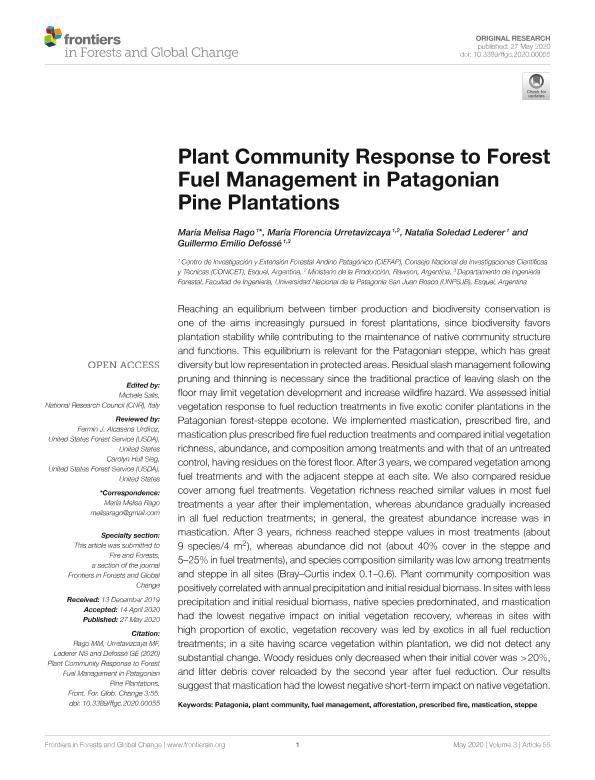Artículo
Plant Community Response to Forest Fuel Management in Patagonian Pine Plantations
Rago, María Melisa ; Urretavizcaya, María Florencia
; Urretavizcaya, María Florencia ; Lederer, Natalia Soledad
; Lederer, Natalia Soledad ; Defossé, Guillermo Emilio
; Defossé, Guillermo Emilio
 ; Urretavizcaya, María Florencia
; Urretavizcaya, María Florencia ; Lederer, Natalia Soledad
; Lederer, Natalia Soledad ; Defossé, Guillermo Emilio
; Defossé, Guillermo Emilio
Fecha de publicación:
05/2020
Editorial:
Frontiers Media
Revista:
Frontiers in Forests and Global Change
ISSN:
2624-893X
Idioma:
Inglés
Tipo de recurso:
Artículo publicado
Clasificación temática:
Resumen
Reaching an equilibrium between timber production and biodiversity conservation is one of the aims increasingly pursued in forest plantations, since biodiversity favors plantation stability while contributing to the maintenance of native community structure and functions. This equilibrium is relevant for the Patagonian steppe, which has great diversity but low representation in protected areas. Residual slash management following pruning and thinning is necessary since the traditional practice of leaving slash on the floor may limit vegetation development and increase wildfire hazard. We assessed initial vegetation response to fuel reduction treatments in five exotic conifer plantations in the Patagonian forest-steppe ecotone. We implemented mastication, prescribed fire, and mastication plus prescribed fire fuel reduction treatments and compared initial vegetation richness, abundance, and composition among treatments and with that of an untreated control, having residues on the forest floor. After 3 years, we compared vegetation among fuel treatments and with the adjacent steppe at each site. We also compared residue cover among fuel treatments. Vegetation richness reached similar values in most fuel treatments a year after their implementation, whereas abundance gradually increased in all fuel reduction treatments; in general, the greatest abundance increase was in mastication. After 3 years, richness reached steppe values in most treatments (about 9 species/4 m2), whereas abundance did not (about 40% cover in the steppe and 5–25% in fuel treatments), and species composition similarity was low among treatments and steppe in all sites (Bray–Curtis index 0.1–0.6). Plant community composition was positively correlated with annual precipitation and initial residual biomass. In sites with less precipitation and initial residual biomass, native species predominated, and mastication had the lowest negative impact on initial vegetation recovery, whereas in sites with high proportion of exotic, vegetation recovery was led by exotics in all fuel reduction treatments; in a site having scarce vegetation within plantation, we did not detect any substantial change. Woody residues only decreased when their initial cover was >20%, and litter debris cover reloaded by the second year after fuel reduction. Our results suggest that mastication had the lowest negative short-term impact on native vegetation.
Archivos asociados
Licencia
Identificadores
Colecciones
Articulos(SEDE CENTRAL)
Articulos de SEDE CENTRAL
Articulos de SEDE CENTRAL
Citación
Rago, María Melisa; Urretavizcaya, María Florencia; Lederer, Natalia Soledad; Defossé, Guillermo Emilio; Plant Community Response to Forest Fuel Management in Patagonian Pine Plantations; Frontiers Media; Frontiers in Forests and Global Change; 3; 5-2020; 1-20
Compartir
Altmétricas



